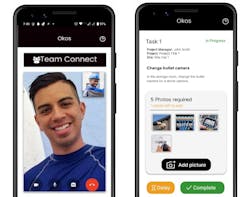This article originally appeared as the cover story in the October 2024 issue of Security Business magazine. Don’t forget to mention Security Business magazine on LinkedIn and @SecBusinessMag on Twitter if you share it.
If you thought artificial intelligence or mergers and acquisitions were the hottest topics in the security industry as of late 2024, you are missing the biggest message being sent from every corner of the service providers’ environment. Everyone is talking about workforce development. Everyone is talking about doing more with fewer people because they simply can’t find skilled pros to help them. Everyone is talking about recruiting and hiring and training and retaining. Everyone is talking about backlogged projects – some of which date back to the supply chain meltdowns of last year.
How can integrators tackle these backlogs without full-time, experienced installation help? What happens when a salesperson has a client who wants to engage an integrator on a project beyond the scope of its installation capabilities? Let that fish get away? What if a potential customer has a facility project in a state where an integrator has no presence? What then?
“I think a lot of integrators now are looking at how many folks they want to staff internally to execute on installation,” explains Chris Wetzel, Principal of Pennsylvania-based integrator CGL Technologies, a Security-Net member. “For my business model today – which is different than the first company I started – I don’t have a lot of people pulling cable. I’d rather sub that out.
“I also want to maintain a healthy backlog, but I can’t tell customers it is going to be six months before I can get their work done,” Wetzel adds. “With most security applications, there’s some sense of urgency – whether it is new construction or there was an incident and something needs to be addressed. Telling them you can’t get there for six months usually doesn’t work very well.”
Boris Besner says he has the answer. Besner is the CEO of a company called Okos, which supplies security technicians to commercial integrators on a per-project basis – a nationwide network of technicians on demand that came along at just the right time to establish a foothold in the industry.
For integrators struggling with workforce development, obtaining an experienced and licensed installation technician for a complicated project can be as easy as ordering a ride on Uber or a dinner on DoorDash.
The Birth of a Concept
Interestingly, Besner’s journey to creating Okos doesn’t come from much of a security background; instead, it stems from his experience in commercial real estate and banking.
Okos (https://OkosSecurity.com) was founded in 2018 to offer a way for residential property management companies to repair, upgrade, and construct apartments to prepare them for residents. The company supplied technicians to install thermostats, door locks, intercoms, and other apartment essentials, eventually landing some very large property management players with tens of thousands of units needing service.
“We had to figure out a new way to install at that scale,” Besner says. “We went the tech-enabled way, and we created an in-house app to track installers, ensure quality control, have full remote project management, and remote diagnostics of everything that is installed. [The app] enabled us to send individuals to installs in many states, make sure the job was getting done right, with all the oversight of being there without actually being on-site. At our peak, we were doing 1,000 apartments per week, every single week.”
With a slowdown in construction in certain areas of the country, the residential apartment market seemed to have reached a ceiling. Besner and his partners wanted more, so in 2019, they decided to shift the company’s entire focus to commercial.
“We pivoted to commercial and institutional installations with the same model using the app for remote installation management,” he says. “We were able to send a tech anywhere, anytime. That’s when we really found our niche in multi-site installations – organizations with 500 locations, for example. For those multi-site projects, you want the touch and the pricing of a local tech, but you also want that project management and full support for a national rollout.”
From there, Besner says Okos was truly born – and it turns out just in time for integrators who were just beginning to understand the true pent-up demand from COVID-19-starved organizations that needed security projects to finally get underway. Besner says security integrators began to take notice.
“The backlogs were crazy,” Besner says. “But the largest integrators saw us as a nationwide sub. Instead of them dealing with 6,000 different subs in different cities across the country, we could be that one point of contact. We’re here to help integrators and IT companies. We don’t want end-customers, so we never steal clients. We’re not in that business. Integrators keep the RMR; they keep the hardware margin. We are there on an install-only basis, and we can do these projects all day long, day after day.”
Clearly, the concept has traction.
“From an integrator’s standpoint, it sounds like a really positive opportunity,” says Merlin Guilbeau, Executive Director and CEO of the Electronic Security Association. “Having access to a program like that gives you confidence that you can go out and sell and get installations done in a timely manner – even if you don’t have somebody trained on staff.”
Who is the Security Gig Worker?
The gig economy can be difficult to define, as it varies widely by industry. Anyone with a driver’s license can become an Uber or Lyft driver, or a delivery person. Anyone with a spare property can rent it out to a traveler. What unites the gig economy is that it involves short-term, flexible jobs that are often ordered and overseen via digital platforms.
Okos is no different – except it is applied to the security installation community. Besner says he has qualified technicians in every U.S. state and parts of Canada. They may be retired security technicians, army veterans, or a tech who is moonlighting and looking to leverage their skills for supplemental income. What unites them is a desire to work on their own schedules.
“It’s a gig economy,” Guilbeau says. “They figured out how to capitalize on that because a lot of the younger folks, that’s what they want to do – they just want to work when they want to work. If they want to not work for three or four days, then they just turn the app off.”
Adds Besner: “We really found our way with part-time and on-demand labor. We are the gig economy of security installs, and when [installers] want to fill in their schedules, they come to us.”
This gives Okos the advantage of speed. “In most major cities, we have 20 or 30 [installers] ready to work. If an integrator needs a big crew for a large project like an airport or a prison, we can send a big crew – and we can be there and ready to start within five days.”
Regarding how the techs identify themselves, Besner says that all depends on the terms in the contract with the integrator. “Some prefer labels, like a shirt with the logo of that integrator, but the majority of our workers just wear black shirts and are non-identifiable.”
Of course, you can’t be the “Uber” or “DoorDash” of security until you have a customer-facing app that enables integrators to request a tech at the touch of a finger. Right now, it still takes a phone call. “We are developing an on-demand portal for service requests,” Besner says.
The Big Question: Ensuring Quality
When informed of such a company, several integrators immediately (and rightly so) questioned how a company like Okos can ensure the quality work of its contracted installers. Besner knows this can be a tripping point, and he has a detailed process of vetting, training, and always overseeing an installer throughout the course of a job.
“It definitely has its pluses for the integrator, especially if the company and the technicians are reliable,” Guilbeau says. “I think it is a positive for the integrator.”
Like the integrators who hire the gig workers, Besner says Okos emphasizes training and certification among its project managers and installers. Okos holds installation certifications for most leading access control, video surveillance, and alarm systems – both hardware and software. Project managers are in the back office constantly monitoring the installers’ app.
“We track by the second, each and every task,” Besner explains. “As the installer finishes each task, they take a photo or a video of it. We have all the quality control built in, and the project manager sees all of it live and can communicate with them. Now that we have installed 10,000 of a certain camera model, we know it will take, on average, 18 minutes to install. If a technician is taking hours, we know something’s wrong, and our project manager is right on top of that via communications and remote diagnostics.”
Besner adds that project managers are specialized in various brands, “so they know how to troubleshoot and support technicians without necessarily always going back to the vendor.”
The integrator also has access to this task-by-task dashboard, as well as a specialized overview of all projects in progress. “The integrator wants to know the project is on track,” Benser says. “If we are working on 50 locations, the dashboard is updated every day – store 229 completed, store 500 completed, etc. The integrator sees all the pictures, all the steps we took, and all the change orders (if any).”
Besner says, all this oversight ensures quality and easily weeds out inefficient or poor technicians. “We are on top of our installs,” he says. “For us, it filters down to training and past experience: If you have a job installing some Axis cameras, the integrator will get a tech who has already installed hundreds of Axis cameras. Yes, sometimes we will need to change or let a technician go. Sometimes it just doesn’t work out. That’s part of the business, and it happens with full-time employees at an integrator the same way.”
Opening New Opportunities for Integrators
The challenges of workforce management are nothing new for integrators. If you hire a full team of installers you have to deal with training, salary, insurance, benefits, liability, quality assurance, travel costs, vacation time, and more. Adding up all those costs, does it make more sense to have a full gig installation workforce, or would it make more sense to have an in-house workforce?
“We have clients who have zero technicians and do not install themselves at all,” Besner says. “They are growing but are not sure when or where the next big project will be. We only charge when there are projects. For an integrator, the installation fees just become a percentage of their project revenues. That’s a predictable plan – and you can even go to the bank with it and finance it. It is a fixed cost.”
An experienced integrator like Wetzel knows that installation costs are one of the most volatile aspects of any project. “The cost for installation is probably my biggest variable on a project, and where I can lose money,” he says. “If I’m able to control that cost and fix it, but still deliver with the quality that we need, I’m all for it.”
Besner says Okos can do it at the local level, anywhere in the U.S. “We don’t charge by the hour; we charge per device,” he says. “If the integrator already knows what they will pay per device for installation, they can mark that up to the end-customer.”
Additionally, a gig workforce can be critical for an integrator looking to expand into a new territory, or with a large client with multiple locations across multiple states in which the integrator may not have a presence.
“For an integrator who’s got a customer with multiple locations, that’s huge because you need to be able to provide a high level of service, not just in the Northeast but across the country, wherever their locations are,” Guilbeau says.
Besner points out that it also works for integrators considering expansion into a new technology category. “If you want to start doing A/V, don’t go out and hire your first A/V technician right away,” he says. “We can grow with an integrator, which is a huge advantage that enables them to grow and scale.”
As for the large national integrators, Besner says they need to leverage the gig workforce simply because of the massive amount of volume they get on a national scale. “If you look at those nationals, you will see 400 open job postings for full-time technicians – positions that they can’t fill. [The gig] pricing model still makes sense, and they are making margin on the installation. We know our role and our spot in the chain, and we price it accordingly.”
Adds Wetzel: “I think it’s a good business model. Having a resource like this that you could pull in and out, allows you to take opportunities that you might otherwise walk away from.”
About the Author
Paul Rothman
Editor-in-Chief/Security Business
Paul Rothman is Editor-in-Chief of Security Business magazine. Email him your comments and questions at [email protected]. Access the current issue, full archives and apply for a free subscription at www.securitybusinessmag.com.



![“Having access to a program like [Okos] gives [integrators] confidence to go out and sell and get installations done in a timely manner – even if they don’t have somebody trained on staff.” - Merlin Guulbeau, Executive Director and CEO of the Electronic Security Association (ESA) “Having access to a program like [Okos] gives [integrators] confidence to go out and sell and get installations done in a timely manner – even if they don’t have somebody trained on staff.” - Merlin Guulbeau, Executive Director and CEO of the Electronic Security Association (ESA)](https://img.securityinfowatch.com/files/base/cygnus/siw/image/2024/10/6712916df3a9ba2293ae6d13-guilbeau_merlin.png?auto=format,compress&fit=max&q=45?w=250&width=250)


